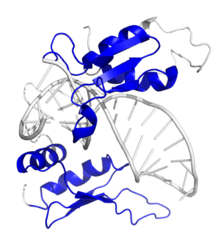
Double-stranded RNA-binding protein Staufen homolog 1 is a protein that in humans is encoded by the STAU1 gene.[5][6][7]
Staufen is a member of the family of double-stranded RNA (dsRNA)-binding proteins involved in the transport and/or localization of mRNAs to different subcellular compartments and/or organelles. These proteins are characterized by the presence of multiple dsRNA-binding domains which are required to bind RNAs having double-stranded secondary structures. The human homologue of staufen encoded by STAU, in addition contains a microtubule-binding domain similar to that of microtubule-associated protein 1B, and binds tubulin. The STAU gene product has been shown to be present in the cytoplasm in association with the rough endoplasmic reticulum (RER), implicating this protein in the transport of mRNA via the microtubule network to the RER, the site of translation. Five transcript variants resulting from alternative splicing of STAU gene and encoding three isoforms have been described. Three of these variants encode the same isoform, however, differ in their 5'UTR.[7]
STAU1 is associated with stress granules.[8]
- ^ a b c GRCh38: Ensembl release 89: ENSG00000124214 – Ensembl, May 2017
- ^ a b c GRCm38: Ensembl release 89: ENSMUSG00000039536 – Ensembl, May 2017
- ^ "Human PubMed Reference:". National Center for Biotechnology Information, U.S. National Library of Medicine.
- ^ "Mouse PubMed Reference:". National Center for Biotechnology Information, U.S. National Library of Medicine.
- ^ DesGroseillers L, Lemieux N (Feb 1997). "Localization of a human double-stranded RNA-binding protein gene (STAU) to band 20q13.1 by fluorescence in situ hybridization". Genomics. 36 (3): 527–529. doi:10.1006/geno.1996.0499. PMID 8884277.
- ^ Kim YK, Furic L, Desgroseillers L, Maquat LE (Jan 2005). "Mammalian Staufen1 recruits Upf1 to specific mRNA 3'UTRs so as to elicit mRNA decay". Cell. 120 (2): 195–208. doi:10.1016/j.cell.2004.11.050. PMID 15680326. S2CID 16786108.
- ^ a b "Entrez Gene: STAU1 staufen, RNA binding protein, homolog 1 (Drosophila)".
- ^ Thomas MG, Martinez Tosar LJ, Loschi M, Pasquini JM, Correale J, Kindler S, Boccaccio GL (January 2005). "Staufen recruitment into stress granules does not affect early mRNA transport in oligodendrocytes". Molecular Biology of the Cell. 16 (1): 405–420. doi:10.1091/mbc.E04-06-0516. PMC 539183. PMID 15525674.






